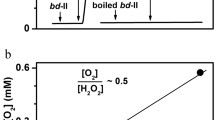Abstract.
Cytochrome d was spectroscopically detected in membrane fractions of the amino-acid-fermenting, high-G+C gram-positive bacterium Corynebacterium glutamicum. Inhibition of NADH oxidase activity in the membranes by cyanide suggested that the main terminal respiratory oxidase during the stationary phase was a type of cytochrome bd. Cytochrome bd-type quinol oxidase, purified from the membranes, was composed of two subunits. Its reduced form showed absorption peaks at 627, 595, and 560 nm, which were due to haem d, high-spin protohaem, and low-spin protohaem, respectively. The air-oxidised form showed a peak at 645 nm, which might be due to oxygenated ferrous haem d. The spectral features and the size of subunit I are more similar to the properties of cytochromes bd from Proteobacteria, such as Escherichia coli, than to those of cytochrome bd from low-G+C gram-positive bacteria, such as Bacillus stearothermophilus. The menaquinol oxidase acitivity of the purified cytochrome bd was low, but was enhanced about fivefold by pre-incubating the enzyme with menaquinones. The order of effectiveness of quinols as oxidase substrates was clearly different from that of quinones as the activators of enzyme activity. Furthermore, activation was destroyed by ultraviolet irradiation of the pre-incubated enzyme and then restored by a second incubation with menaquinone. These results indicate that the enzymatic properties of this new oxidase are more similar to the properties of cytochromes bd from low-G+C gram-positive bacterial than to those of proteobacterial counterparts. They also suggest that the enzyme has a second quinone-binding site essential for full activity, in addition to the active centre for substrate oxidation. By using probes based on partial peptide sequences of the subunits, the genes for the two subunits of C. glutamicum cytochrome bd were cloned. The deduced amino acid sequence demonstrated that subunit I lacks the C-terminal half of the Q loop and that the primary structure of C. glutamicum cytochrome bd is more similar to that of other gram-positive bacteria than to proteobacterial cytochromes bd.
Similar content being viewed by others
Author information
Authors and Affiliations
Additional information
Electronic Publication
Rights and permissions
About this article
Cite this article
Kusumoto, K., Sakiyama, M., Sakamoto, J. et al. Menaquinol oxidase activity and primary structure of cytochrome bd from the amino-acid fermenting bacterium Corynebacterium glutamicum . Arch. Microbiol. 173, 390–397 (2000). https://doi.org/10.1007/s002030000161
Received:
Revised:
Accepted:
Published:
Issue Date:
DOI: https://doi.org/10.1007/s002030000161




